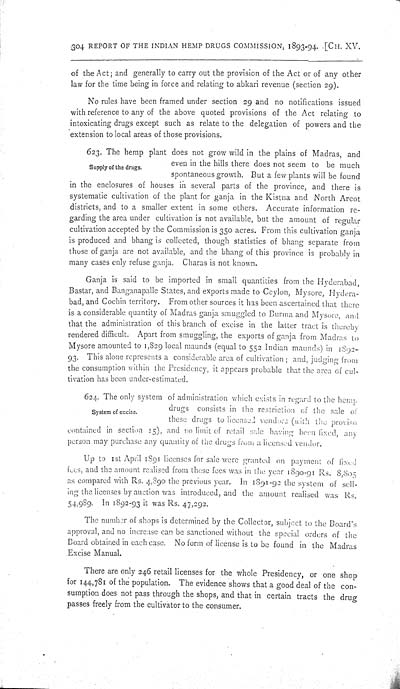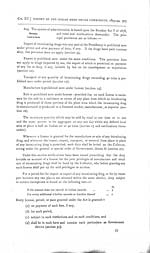Medicine - Drugs > Report of the Indian Hemp Drugs Commission, 1894-1895 > Volume I
(338) Page 304
Download files
Individual page:
Thumbnail gallery: Grid view | List view

304 REPORT OF THE INDIAN HEMP DRUGS COMMISSION, 1893-94. [CH. XV.
of the Act; and generally
to carry out the provision of the Act or of any other
law for the time being in force and relating to abkari revenue
(section 29).
No rules have been framed
under section 29 and no notifications issued
with reference to any of the above quoted provisions of the Act
relating to
intoxicating drugs except such as relate to the delegation of
powers and the
extension to local areas of those provisions.
Supply of the drugs.
623. The hemp plant does
not grow wild in the plains of Madras, and
even in the hills there does
not seem to be much
spontaneous growth. But a few plants will be found
in the enclosures of houses in several parts of the province, and
there is
systematic cultivation of the plant for ganja in the Kistna and
North Arcot
districts, and to a smaller extent in some others. Accurate
information re-
garding the area under cultivation is not available, but the amount
of regular
cultivation accepted by the Commission is 350 acres. From this
cultivation ganja
is produced and bhang is collected, though statistics of bhang
separate from
those of ganja are not available, and the bhang of this province is
probably in
many cases only refuse ganja. Charas is not known.
Ganja is said to be
imported in small quantities from the Hyderabad,
Bastar, and Banganapalle States, and exports made to Ceylon,
Mysore, Hydera-
bad, and Cochin territory. From other sources it has been
ascertained that there
is a considerable quantity of Madras ganja smuggled to Burma and
Mysore, and
that the administration of this branch of excise in the latter
tract is thereby
rendered difficult. Apart from smuggling, the exports of ganja from
Madras to
Mysore amounted to 1,829 local maunds (equal to 552 Indian maunds)
in 1892-
93. This alone represents a considerable area of cultivation; and,
judging from
the consumption within the Presidency, it appears probable that the
area of cul-
tivation has been under-estimated.
System of excise.
624. The only system of
administration which exists in regard to the hemp
drugs consists in the
restriction of the sale of
these drugs to licensed vendors (with the proviso
contained in section 15), and no limit of retail sale having been
fixed, any
person may purchase any quantity of the drugs from a licensed
vendor.
Up to 1st April 1891
licenses for sale were granted on payment of fixed
fees, and the amount realised from these fees was in the year
1890-91 Rs. 8,805
as compared with Rs. 4,890 the previous year. In 1891-92 the system
of sell-
ing the licenses by auction was introduced, and the amount realised
was Rs.
54,989. In 1892-93 it was Rs. 47,292.
The number of shops is
determined by the Collector, subject to the Board's
approval, and no increase can be sanctioned without the special
orders of the
Board obtained in each case. No form of license is to be found in
the Madras
Excise Manual.
There are only 246 retail
licenses for the whole Presidency, or one shop
for 144,781 of the population. The evidence shows that a good deal
of the con-
sumption does not pass through the shops, and that in certain
tracts the drug
passes freely from the cultivator to the consumer.
Set display mode to: Large image | Zoom image | Transcription
Images and transcriptions on this page, including medium image downloads, may be used under the Creative Commons Attribution 4.0 International Licence unless otherwise stated. ![]()
| India Papers > Medicine - Drugs > Report of the Indian Hemp Drugs Commission, 1894-1895 > Volume I > (338) Page 304 |
|---|
| Permanent URL | https://digital.nls.uk/74574742 |
|---|---|
| Description | Chapter XV, cont. |
| Description | [Volume 1]: Report. |
|---|---|
| Attribution and copyright: |
|




